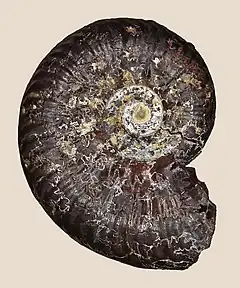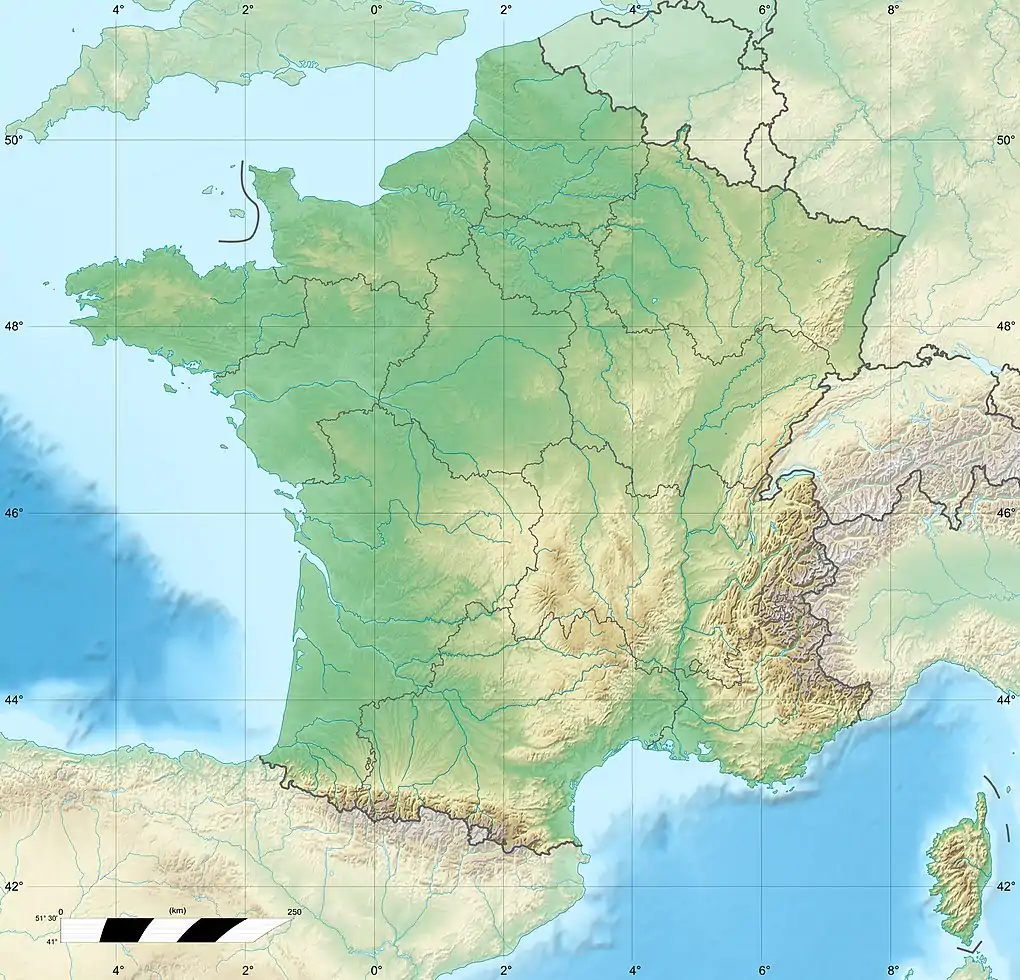Toarcien National Nature Reserve
The Toarcien National Nature Reserve (RNN91) is a French national nature reserve located in Nouvelle-Aquitaine, near the city of Thouars, from which the name Toarcian is derived. Established in 1987, it occupies an area of 0.61 hectares, making it the smallest national nature reserve in France. It protects two former quarries preserving the stratotype of the Toarcian stage.[1]
| Toarcien National Nature Reserve | |
|---|---|
| Location | Deux-Sèvres, France |
| Nearest city | Sainte-Verge |
| Coordinates | 47.0025°N 0.243°W |
| Area | 0,61 ha |
| Established | 23 November 1987 |
| Governing body | Communauté de communes du Thouarsais |
| Toarcien National Nature Reserve | |
|---|---|
| Stratigraphic range: | |
 Haugia variabilis, an ammonite from the Toarcian of France. | |
| Type | Geological formation |
| Thickness | 7.6 m |
| Lithology | |
| Primary | Limestone |
| Other | Marl and sandstone |
| Location | |
| Coordinates | 47.0025°N 0.243°W |
| Region | |
| Country | |
| Type section | |
| Named for | Thouars |
 Toarcien National Nature Reserve (France) | |
Location
The nature reserve domain is in the Deux-Sèvres department, near the commune of Sainte-Verge. It consists of two former open-air quarries separated by a few hundred meters in the Thouet valley. The first is located in the location "Les Groies", and the second approximately 500 meters south, in the location "Les Hauts-Côteaux".[2] It bears the stratotype of the Toarcian, the latest stage of the Early Jurassic.[3][4]
Its total area spreads overs 0.61 hectares[1][2] (or 6 100 m2), making it the smallest national nature reserve in France. There is, however, several smaller regional nature reserves.[5]
Ecology
The ammonite species having evolved quite rapidly, they are used as a geological marker for the terrains that bears them. The Toarcian stage is divided in 34 elementary units or "horizons". Each horizon correspond to a period of approximately 260 000 years, and is characterized by one or several specific ammonite species.[6]
Geology
The Hauts-Côteaux quarry presents a cross-section significantly more developed than the Groies quarry. It bears, from bottom to top :
- ferruginous sandstone and gravelly limestone (> 0.50 m). It includes few fossils, notably bivalves (Pectinidae), gastropods and belemnites, and shows very numerous worm borrows ;
- bioclastic limestone with ferruginous oolites (1.20 m). It is extremely rich in bioclasts (essentially fragmentary shells of bivalves and gastropods) and ferruginous oolites, small spheres made of thin concentric layers of iron oxide. Ammonites and belemnites can also be found. Those are dated from the Early and Middle Toarcian ;
- argillaceous limestone alternating with marl (6.90 m). It contains also numerous fossils of pelagic organisms, mostly animals who lived in open waters (ammonites, nautilus, belemnites...). It spreads from the late Middle Toarcian to the Early Aalenian.[3]
Tools and legal status
The nature reserve was established by decree the 23 November 1987.[2] Articles 5 to 11 of the decree regulate the reserve and specify several restrictions. Article 5 indicates that "it is forbidden to harm in any way the coal front, the mineral substance or fossils from the reserve.[2]"
References
- Muséum national d'Histoire naturelle (2003). "Toarcien (FR3600091)". Inventaire national du Patrimoine naturel. Retrieved 29 December 2013.
- "Décret numéro 87-950 du 23 novembre 1987 PORTANT CREATION DE LA RESERVE NATURELLE DU TOARCIEN (DEUX-SEVRES)". Legifrance.
- "Réserve naturelle nationale du Toarcien" (PDF). RNF.
- "Communauté de communes du Thouarsais - Réserve Naturelle de France du Toarcien". www.thouars-communaute.fr. Retrieved 2022-03-02.
- RNF (2013). "Liste des réserves naturelles". Réserves Naturelles de France. Retrieved 6 April 2014.
- Jonin, Max (2006). Delachaux et Niestlé (ed.). Mémoire de la Terre, Patrimoine géologique français. Lonay (Suisse)/Paris. p. 191. ISBN 2-603-01383-1.
{{cite book}}: CS1 maint: location missing publisher (link)